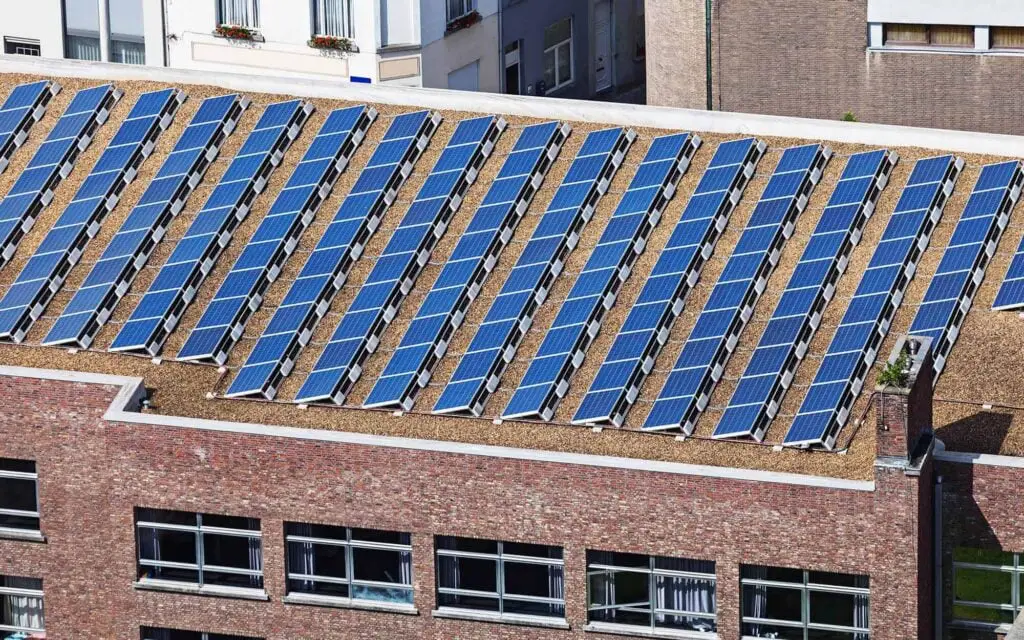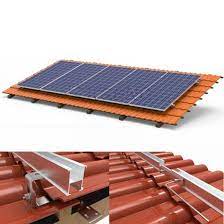Contents
- 1 Introduction
- 2 The Solar Revolution: From Roofs to Tiles
- 3 Solar Panel Roof Mounts: A Critical Component
- 4 Solar Panel Roof Tiles: Aesthetic and Functional
- 5 Advantages of Solar Panel Roof Tiles
- 6 Solar Panel Roof Tiles vs. Traditional Solar Panels
- 7 Installation and Maintenance
- 8 The Future of Solar Panel Technology
- 9 The Environmental Impact
- 10 Financial Incentives and Tax Credits
- 11 Conclusion
Introduction
Solar panel roofs, solar panel roof mounts, and solar panel roof tiles as the world faces the critical challenge of transitioning towards renewable and sustainable energy sources, solar power has emerged as a beacon of hope. Solar panels, capable of converting sunlight into electricity, have become increasingly popular for homeowners and businesses looking to reduce their carbon footprint and energy bills. In this comprehensive article, we will delve into the world of solar panel roofs, mounts, and tiles. We will explore the innovative technologies and mounting solutions that enable solar panels to be seamlessly integrated into residential and commercial buildings.

The Solar Revolution: From Roofs to Tiles
The journey of solar energy has witnessed a remarkable transformation over the years. Initially, solar panels were installed as additional fixtures on roofs, but technology has since evolved to create more integrated solutions. The latest advancement in this field is the development of solar panel roof tiles. These tiles are designed to replace traditional roofing materials while generating clean, sustainable energy.
a. Traditional Solar Panels: Standard solar panels, also known as photovoltaic (PV) panels, are attached to existing roofs using racks and mounts. While effective, this method often means an added layer of installation on top of the existing roof, which can be visually less appealing and less efficient in terms of space utilization.
b. Solar Panel Roof Tiles: Solar panel roof tiles, on the other hand, serve a dual purpose. They provide the primary function of roofing while seamlessly integrating solar cells for energy generation. These tiles are designed to mimic the look of traditional roofing materials, making them an attractive option for those who value aesthetics and energy efficiency.

Solar Panel Roof Mounts: A Critical Component
Solar panels, whether in the form of traditional panels or roof tiles, require sturdy and efficient mounts to ensure proper installation and maximize energy production. Solar panel roof mounts are crucial components of any solar energy system and come in various designs and configurations.
a. Types of Roof Mounts:
- Roof-Top Mounts: These are the most common and cost-effective type of solar panel mounts. They are attached directly to the existing roof, whether it is flat or sloped. Roof-top mounts can be fixed or adjustable to optimize the panel’s angle toward the sun.
- Ground Mounts: In cases where roof-mounted panels are not feasible, ground-mounted systems are an alternative. These systems are set up on the ground, offering flexibility in panel placement and adjustments.
- Flush Mounts: Flush mounts are designed to create a seamless, visually pleasing integration with the roof. They sit flat against the roof’s surface, reducing the visual impact of the solar installation.
- Tilted Mounts: For areas with varying sun angles, tilted mounts allow for adjusting the angle of the panels to maximize sun exposure and energy production.
b. Mounting Considerations:
- Roof Compatibility: Not all roof types are suitable for solar panel installation. It’s essential to consider the type of roof, its condition, and the load-bearing capacity when selecting mounting options.
- Aesthetics: The appearance of solar panel installations is a critical consideration, especially for residential applications. Flush mounts and integrated systems like solar panel roof tiles provide a more visually appealing option.
- Local Regulations: Local building codes and regulations may dictate the type of mounts that can be used, as well as their placement on the roof.
- Solar Panel Orientation: The direction in which the panels are mounted can significantly impact energy production. Proper orientation ensures that the panels receive maximum sunlight throughout the day.

Solar Panel Roof Tiles: Aesthetic and Functional
Solar panel roof tiles are a revolutionary development in the field of solar energy. These tiles seamlessly blend into the architecture of a building while harnessing the power of the sun. Here are some key aspects of solar panel roof tiles:
a. Aesthetic Appeal: Solar panel roof tiles are designed to mimic traditional roofing materials, such as asphalt shingles, clay tiles, or slate. This design aspect makes them an attractive choice for homeowners and businesses looking to maintain the visual integrity of their buildings.
b. Durability: Solar panel roof tiles are built to withstand the elements. They are typically made from robust materials that can endure harsh weather conditions, including rain, snow, wind, and hail.
c. Energy Efficiency: Solar panel roof tiles are as efficient as traditional solar panels in harnessing solar energy. They have photovoltaic cells embedded within the tiles, which convert sunlight into electricity. This means they generate power while providing roofing functionality.
d. Installation: Installing solar panel roof tiles requires a level of expertise due to their integration into the roofing system. It’s crucial to work with experienced installers who can ensure a watertight seal and proper electrical connections.
e. Cost Considerations: Solar panel roof tiles tend to be more expensive than traditional solar panels and roofing materials when considered separately. However, they can offer long-term cost savings by generating electricity and potentially increasing property value.
f. Solar Panel Roof Tile Manufacturers: Several companies, including Tesla, CertainTeed, and SunPower, offer solar panel roof tiles. These companies have developed their unique designs and technologies for integrating solar power into roofing materials.
Advantages of Solar Panel Roof Tiles
Solar panel roof tiles offer numerous advantages, making them a compelling choice for many building owners:
a. Aesthetic Integration: Solar panel roof tiles blend seamlessly into the roof, preserving the architectural beauty of the building. This is especially important for historical or visually sensitive locations.
b. Space Utilization: Solar panel roof tiles make efficient use of available space. The entire roof area becomes a solar energy generator, maximizing energy production.
c. Enhanced Property Value: Homes and commercial properties with solar panel roof tiles tend to have higher resale values. Potential buyers are attracted to the prospect of lower energy bills and a sustainable energy source.
d. Weather Resistance: Solar panel roof tiles are designed to withstand extreme weather conditions, providing a long-lasting and durable roofing solution.
e. Reduced Environmental Impact: The integration of solar power into roofing materials reduces the need for additional materials and installation, resulting in a lower carbon footprint.
Solar Panel Roof Tiles vs. Traditional Solar Panels
When deciding between solar panel roof tiles and traditional solar panels, it’s essential to consider various factors to make an informed choice. Here’s a comparison of the two options:
a. Aesthetic Considerations:
- Solar Panel Roof Tiles: Solar panel roof tiles are designed to blend seamlessly into the roof, preserving the building’s aesthetics.
- Traditional Solar Panels: Traditional panels are typically mounted on top of existing roofs, which can affect the building’s appearance.
b. Space Utilization:
- Solar Panel Roof Tiles: Solar panel roof tiles make efficient use of the entire roof area, maximizing energy production.
- Traditional Solar Panels: Traditional panels may require additional space for installation, reducing the available roof space.
c. Installation:
- Solar Panel Roof Tiles: Installation requires expertise to ensure a watertight seal and electrical connections, making it potentially more complex.
- Traditional Solar Panels: Standard panel installation is more straightforward and can be done on most roof types.
d. Cost:
- Solar Panel Roof Tiles: Solar panel roof tiles tend to be more expensive than traditional panels and roofing materials when considered separately.
- Traditional Solar Panels: Traditional panels are generally more cost-effective.
e. Energy Efficiency:
- Solar Panel Roof Tiles: Solar panel roof tiles are as efficient as traditional panels in harnessing solar energy.
- Traditional Solar Panels: Standard panels are highly efficient in converting sunlight into electricity.
f. Durability:
- Solar Panel Roof Tiles: Solar panel roof tiles are designed to withstand harsh weather conditions and offer long-lasting performance.
- Traditional Solar Panels: Traditional panels are also durable but may be more exposed to the elements, depending on the installation method.
g. Customization:
- Solar Panel Roof Tiles: Solar panel roof tiles may come in various designs and styles to suit different architectural preferences.
- Traditional Solar Panels: Traditional panels have a uniform design and are typically less customizable in terms of appearance.
h. Maintenance:
- Solar Panel Roof Tiles: Solar panel roof tiles require minimal maintenance and can be cleaned as part of regular roof maintenance.
- Traditional Solar Panels: Traditional panels may accumulate dust and debris, requiring periodic cleaning to maintain optimal performance.
i. Long-Term Savings:
- Solar Panel Roof Tiles: Solar panel roof tiles offer long-term savings through energy generation and, potentially, an increase in property value.
- Traditional Solar Panels: Traditional panels provide substantial long-term savings on energy bills but may not contribute to property value in the same way.
Ultimately, the choice between solar panel roof tiles and traditional solar panels depends on your priorities, budget, and aesthetic preferences. Both options offer the benefits of clean energy production and reduced environmental impact, but the decision should align with your specific needs and goals.
Installation and Maintenance
Proper installation and regular maintenance are essential for ensuring the optimal performance and longevity of a solar panel roof system, whether it consists of solar panel roof tiles or traditional solar panels.
a. Installation:
- Professional Installation: It is highly recommended to have solar panels installed by experienced professionals. This is especially crucial for solar panel roof tiles, as they must be seamlessly integrated into the roofing system.
- Roof Assessment: Before installation, the condition of the existing roof should be assessed to ensure that it can support the additional weight of the solar panels. Roof repairs or upgrades may be necessary.
- Wiring and Electrical: Proper electrical connections and wiring are critical to ensure the safe and efficient operation of the solar panels. Qualified electricians should handle this aspect of the installation.
b. Maintenance:
- Cleaning: Regularly cleaning the solar panels, whether they are roof tiles or traditional panels, is essential to maintain their efficiency. Dust, dirt, and debris can accumulate and reduce energy production.
- Roof Inspection: In the case of solar panel roof tiles, periodic roof inspections are necessary to check for any potential issues with the roofing system, including leaks or damage.
- Inverter and Battery Maintenance: If your solar system includes inverters and batteries, they also require periodic maintenance to ensure they function correctly.
- Monitoring: Many solar systems come with monitoring systems that allow you to track the performance of your panels. Regularly reviewing this data can help you identify and address any issues promptly.
The Future of Solar Panel Technology
The solar energy industry continues to evolve, with ongoing research and innovation leading to breakthroughs in efficiency, cost-effectiveness, and design. Some emerging trends and technologies in the field include:
a. Bifacial Solar Panels: Bifacial solar panels are designed to capture sunlight from both sides, increasing energy production. They can be a valuable addition to solar panel roof systems.
b. Thin-Film Solar Cells: Thin-film solar cells are lightweight and flexible, making them suitable for a variety of applications, including solar roof tiles.
c. Building-Integrated Photovoltaics (BIPV): BIPV technologies are designed to seamlessly integrate solar power into building materials, offering more options for architects and builders.
d. Solar Paint: Researchers are working on solar paint that can be applied to surfaces, transforming them into solar energy generators.
e. Increased Efficiency: Ongoing efforts are directed towards enhancing the efficiency of solar cells, allowing for improved energy production in a smaller footprint.
f. Storage Solutions: Innovations in energy storage, such as advanced batteries, are making it possible to store excess energy for later use, increasing the reliability of solar power.
The Environmental Impact
One of the primary motivations for transitioning to solar energy is its positive impact on the environment. Solar panels, whether traditional or integrated into roofing materials, significantly reduce greenhouse gas emissions by generating clean, renewable energy. Solar energy systems have several environmental benefits:
a. Reduced Carbon Emissions: Solar panels produce electricity without emitting harmful greenhouse gases, helping to mitigate climate change.
b. Decreased Fossil Fuel Dependency: Solar power reduces our reliance on fossil fuels, which are finite resources associated with environmental degradation and geopolitical conflicts.
c. Lower Energy Production-Related Pollution: Solar energy production involves minimal environmental pollution compared to fossil fuel-based energy generation.
d. Conservation of Natural Resources: Solar energy harnesses the power of the sun, a virtually limitless and sustainable resource, without depleting finite fossil fuels or causing habitat destruction.
e. Reduced Heat Island Effect: Solar panels can reduce the urban heat island effect by shading roofs and reflecting less heat back into the atmosphere, thereby helping to mitigate the impacts of climate change in urban areas.
f. Water Conservation: Unlike many conventional power plants that require large quantities of water for cooling, solar panels do not consume water for energy generation.
Financial Incentives and Tax Credits
To encourage the adoption of solar panel technology, governments at the federal, state, and local levels offer various financial incentives and tax credits. These incentives can significantly reduce the cost of installing solar panel roofs, mounts, or tiles. Some common incentives include:
a. Federal Investment Tax Credit (ITC): The Federal ITC provides a tax credit equal to a percentage of the cost of solar panel installation. As of my last knowledge update in 2022, it offers a 26% credit for residential and commercial solar installations. However, the ITC rate may change, so it’s essential to check the current rate.
b. State and Local Incentives: Many states offer their incentives, such as rebates, tax credits, and performance-based incentives, to encourage solar energy adoption. The availability and extent of these incentives vary by location.
c. Net Metering: Net metering programs allow solar system owners to earn credits for excess electricity produced and feed it back into the grid. These credits can offset future electricity bills.
d. Solar Renewable Energy Credits (SRECs): In some regions, solar system owners can earn SRECs by generating a certain amount of solar electricity. These credits can be sold in a market, providing an additional income stream.
e. Property Tax Exemptions: Some states offer property tax exemptions for solar energy systems, reducing the property tax associated with the increased home value.
Conclusion
Solar panel roofs, mounts, and tiles represent an exciting chapter in the world of sustainable energy. They offer the potential to turn every building into a clean energy generator, reducing carbon emissions and energy bills while enhancing property values.
Whether you choose traditional solar panels or opt for the aesthetics and functionality of solar panel roof tiles, the decision to harness the power of the sun is an investment in the environment and your financial future. With ongoing advancements in technology and supportive financial incentives, the future of solar energy is looking brighter than ever. As we strive to build a more sustainable world, solar panel roofs and associated technologies will play a vital role in shaping our energy landscape for years to come.
